II. Material/Film
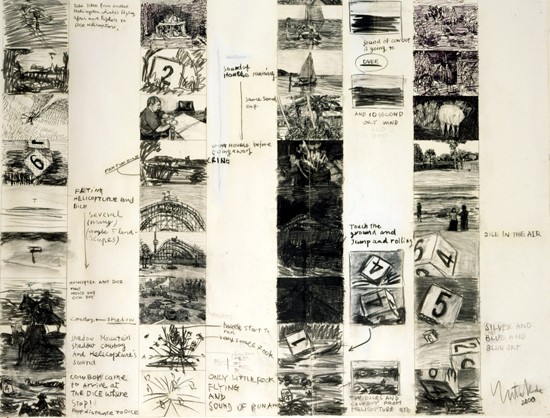
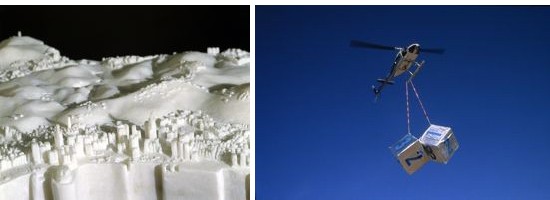
Top: Detail of Storyboard for Never Ever Movie (2000), marker, charcoal and paint on paper, 192.4 x 241.3 cm. Left: Detail of Hong Kong Island (Chinese) (1998), carved marble, 65 x 120 x 80 cm. Right: Still from Double Six (San Antonio) (2000), video, 6 min, 40 sec. All images: Unless otherwise noted courtesy Yutaka Sone and David Zwirner, New York.
ART iT: We were just discussing how when you carve there is a collapse of different temporal scales that becomes both meditative and “sexy.” Could you say that this also develops from a kind of respect for the material, or is that not so much of an issue for you?
YS: I think you could say that. The one exception would perhaps be paint. I discriminate against paint, and brushes. I have my own style for brushes. I like damaged brushes. I’ll take cheap brushes and cut their bristles up into shapes that I like, making the hairs really short, or loosening up the brushes that have almost hardened and then reusing them. In fact, that’s a kind of respect.
I have no excuses for the way I treat paint though. Doing nasty things to my brushes is my way of showing them love. But I have the habit of not using a palette. That’s no good. I need to reform. I’ll pick up a tube and start squirting paint right onto the brush. When I’m going for volume I’ll squeeze a lot of paint out and slap it onto the canvas. I guess I can think of painting as one of the small plots in my garden. Maybe in 10 years’ time I’ll be using a palette and doing proper oil paintings, although I can’t stand the smell of the oil.
ART iT: In terms of expression, did it take a long time to figure out this way of “living,” or was it something that was there from the start of your activities as an artist?
YS: To an extent it was there from the beginning. Although I couldn’t afford to work with expensive materials like crystal, even then I was already taking notes on all my ideas and drawing plans out every day, just as I do now.
For example, I would draw out a storyboard for a movie I was planning and then that would end up becoming a sculpture, with the topic shifting and transforming into something else – as in the case of the marble work Hong Kong Island (1998). Even now there are all kinds of projects for which I’m still not clear exactly where they are headed. My home is a junkyard of half-started works.
At a museum people only see my finished projects, but the way that I stack up the works in my studio is pretty awful. Any art person who sees it would burst into tears. I leave my paintings lying around out back of the studio and they get drenched in the rain. Or my cats start using the stone carvings as toilets, and then before I send them to the museums I have to rinse my works off until the smell goes away. Cleaning them up is always a big production.
There’s another work that fell apart almost as soon as I started it and is now just lying there as is – this is in fact the first model for my weaving project. I was trying to make something tropical like a palm tree or a banana tree, but because I didn’t understand the material I decided to do a model in clay first. I started with Styrofoam and added clay on top of that and added these leaves that I picked up from a gift shop somewhere, and that was the first stage in how I imagined the project. Now the prototype at home is in fantastically decrepit condition, with bits of clay flaking off and moldy patches that were wet and have dried out again. I still plan to keep it around for a bit longer until I finish the project.
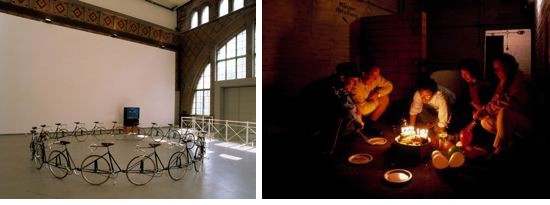
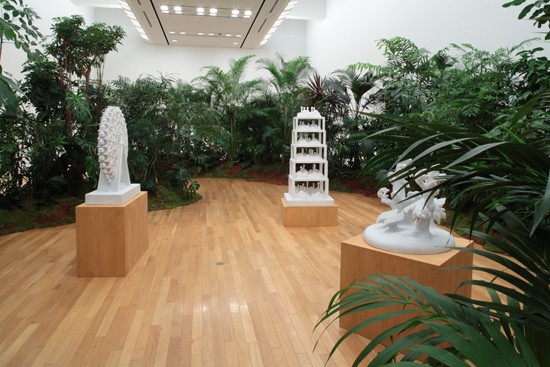
Left: Installation view of Her 19th Foot (1993) in the exhibition “Yutaka Sone: Nutopi” at the Rooseum Center for Contemporary Art, Malmö, 1995. Right: Still from the video Birthday Part (1997). Bottom: Installation view of the exhibition “Perfect Moment” at Tokyo Opera City Art Gallery, 2011. Photo Keizo Kioku.
ART iT: What you say about your yard reminds me that previously in works like Birthday Party and Her 19th Foot you integrated video and photographic documentation of the process into the final installations. Does the fact that you no longer do this mean that you are confident that the process is now apparent in your finished works?
YS: At the time of Birthday Party and Her 19th Foot I was mostly making videos because I didn’t have any money. Now I’m taking a “sharper angle.”
Another consideration was the balance between the scope of the exhibition and what I was making. Whenever the adjustment between my own speed and the speed of the exhibition didn’t go well then I would end up doing a work in progress, even if that was not my original intent. It was a necessary outcome – there wasn’t enough time, or I didn’t have enough energy.
And then I simply didn’t have the economic means to control those projects. Sometimes I would produce something consisting solely of ideas, whereas now things are more settled for me, and my projects are much more involved and intensive. For my first 15 or so years as an artist I didn’t even have a studio. I put all my ideas down in memos, and I was borrowing different spaces for each project. It wasn’t until I moved to Los Angeles that I had my first studio, and then before I knew it I had three. I don’t know if this answers your question.
ART iT: Well, I just wonder how much of the creative process itself we are meant to extrapolate from the appearance of your carved marble and crystal works, and whether there’s any compensation for the documentary material that you previously included in your installations.
YS: I’m practically living in a junkyard, and I don’t think that makes for a very artistic setting. Depicting that won’t add anything to the work. Right now I’m exclusively devoted to making works. No matter what, it takes time to work with stone. Compared with 10 or 15 years ago, I better understand my own capabilities and limitations, but even supposing I maintain my current pace of production for another decade, I can still count up the number of works that I will be able to complete in that time span. I first realized this about five or six years ago and it put me into a frenzy. I need to make works, I need to use all the time I have left for production.
The other thing is that when my children were small, I had to help look after them, but now that they are older I am trying to expend all my time on art. Or rather, I am trying as much as possible to avoid doing anything else, because I still have several dream projects that I won’t be able to realize otherwise.
ART iT: In this regard how do you assess those early works like Birthday Party and Her 19th Foot? Have you reevaluated the approach you took in those projects at all?
YS: It’s like those works are my children. I’ve seen them grow from babies into young adults. The early works are my eldest children. They fill me with pride. I wanted them to grow up that way. I mean – I like them. I like all my works. My mindset for making any work is relatively consistent, so there really isn’t anything I dislike. If I dislike something I’ll scrap it before showing it.
There may be some specific areas for reevaluation, but even the mistakes that were involved in those works have accrued into forming my current self, and any critique that I did of those works would necessarily become a critique of my current state of mind. I don’t really have anything to say about them. Nobody can change the past.
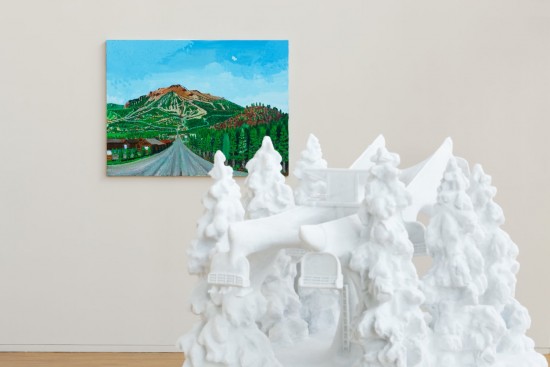
Installation view of the exhibition “Snow” at Maison Hermès Le Forum, Tokyo, 2010. Courtesy Fondation d’entreprise Hermès, © Nacása & Partners Inc.
ART iT: But clearly in comparing the early and recent works there has been a change in your approach over time. Was there any particular impetus for that change?
YS: I have changed subtly everyday. Comparing the early and recent works, I would say there’s a difference between the things that I want to make and the things that I am asked to make, and that has always been a frustration for me. Galleries and curators constantly ask me to make this or that kind of work, but there’s a gap between what they want and what I want. In that sense there hasn’t been much of a change from my past self to my present. Even now I try to approach every exhibition as if it were my first.
In fact, recently I’ve been struggling with ways to maintain that sense of excitement and apprehension. I practice the guitar every day. I’m still a beginner, but the great thing about that is you can really feel yourself improving. I have no desire to become an expert; it’s more like being a beginner and practicing every day, changing every day, and feeling the excitement of that pace of development produces a second adolesence for me. Recently my strategy has been to try to grab hold of that youthful apprehension and apply it to my art, so that even now I can make works that burst with excitement.
Part I: Yutaka Sone on his creative approach
Part III: Sculpting in Time
Yutaka Sone: The Patience of Materials
